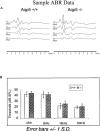Expression of aquaporin 1 and 5 in the developing mouse inner ear and audiovestibular assessment of an Aqp5 null mutant
- PMID: 12943377
- PMCID: PMC3202717
- DOI: 10.1007/s10162-002-3033-7
Expression of aquaporin 1 and 5 in the developing mouse inner ear and audiovestibular assessment of an Aqp5 null mutant
Abstract
To examine the potential roles of aquaporins 1 and 5 (AQP1 and AQP5, respectively) in inner ear development and function, we defined their spatial and temporal expression patterns in the developing mouse inner ear and examined the morphologic and physiologic effects of loss of Aqp5 function. Standard in situ hybridization (ISH) and immunohistochemical (IHC) assays were used for expression studies with routine morphologic, behavioral, and physiologic assessments of hearing and balance in Aqp5 null mutant mice. AQP1 was first detected at embryonic day 10.5 (E10.5) in the otocyst but eventually localized to specific nonsensory portions of the inner ear and connective tissue cells surrounding the membranous labyrinth. AQP5 displayed specific cochlear expression, first detectable at E15.5 in the nonsensory epithelium and later restricted to the lateral wall of the cochlear duct near the spiral prominence. AQP5 expression continued through postnatal periods with a change of expression domain to the stria vascularis between postnatal day 7 (P7) and P14. By in situ hybridization and immunohistochemical techniques, subtle differences between transcript and protein expression patterns were noted for both AQP1 and 5. Although AQP5 is dynamically expressed in the developing mouse inner ear, adult Aqp5 knockout mice show normal hearing when tested and normal inner ear structural development. These results suggest redundant or alternative mechanisms that likely regulate water homeostasis in the developing and mature inner ear.
Figures







Similar articles
-
Developmental expression of aquaporin 2 in the mouse inner ear.Laryngoscope. 2000 Nov;110(11):1925-30. doi: 10.1097/00005537-200011000-00030. Laryngoscope. 2000. PMID: 11081612
-
Mice lacking the B1 subunit of H+ -ATPase have normal hearing.Hear Res. 2003 Jun;180(1-2):76-84. doi: 10.1016/s0378-5955(03)00108-4. Hear Res. 2003. PMID: 12782355
-
Identification of aquaporin 5 (AQP5) within the cochlea: cDNA cloning and in situ localization.Biochem Biophys Res Commun. 1999 Oct 14;264(1):157-62. doi: 10.1006/bbrc.1999.1323. Biochem Biophys Res Commun. 1999. PMID: 10527857
-
Aquaporins as potential drug targets for Meniere's disease and its related diseases.Handb Exp Pharmacol. 2009;(190):171-84. doi: 10.1007/978-3-540-79885-9_8. Handb Exp Pharmacol. 2009. PMID: 19096777 Review.
-
Water channel proteins in the inner ear and their link to hearing impairment and deafness.Mol Aspects Med. 2012 Oct-Dec;33(5-6):612-37. doi: 10.1016/j.mam.2012.06.004. Epub 2012 Jun 23. Mol Aspects Med. 2012. PMID: 22732097 Review.
Cited by
-
The -1364A/C Aquaporin 5 Gene Promoter Polymorphism Is Not Associated with Menière's Disease.ISRN Otolaryngol. 2012 Oct 16;2012:706896. doi: 10.5402/2012/706896. Print 2012. ISRN Otolaryngol. 2012. PMID: 23762616 Free PMC article.
-
Signaling Mechanisms and Pharmacological Modulators Governing Diverse Aquaporin Functions in Human Health and Disease.Int J Mol Sci. 2022 Jan 26;23(3):1388. doi: 10.3390/ijms23031388. Int J Mol Sci. 2022. PMID: 35163313 Free PMC article. Review.
-
Quantitative Analysis of Aquaporin Expression Levels during the Development and Maturation of the Inner Ear.J Assoc Res Otolaryngol. 2017 Apr;18(2):247-261. doi: 10.1007/s10162-016-0607-3. Epub 2016 Dec 21. J Assoc Res Otolaryngol. 2017. PMID: 28004290 Free PMC article.
-
Role of aquaporins in brain water transport and edema.Front Neurosci. 2025 Jan 29;19:1518967. doi: 10.3389/fnins.2025.1518967. eCollection 2025. Front Neurosci. 2025. PMID: 39944892 Free PMC article. Review.
-
Severe neurologic impairment in mice with targeted disruption of the electrogenic sodium bicarbonate cotransporter NBCe2 (Slc4a5 gene).J Biol Chem. 2011 Sep 16;286(37):32563-74. doi: 10.1074/jbc.M111.249961. Epub 2011 Jun 24. J Biol Chem. 2011. PMID: 21705333 Free PMC article.
References
-
- Arenberg I. Results of the first 300 consecutive endolymphatic system-mastoid shunts with valve implants for hydrops. Otolaryngol. Clin. North Am. 1982;16:153–174. - PubMed
Publication types
MeSH terms
Substances
Grants and funding
LinkOut - more resources
Full Text Sources
Medical
Molecular Biology Databases
Research Materials

